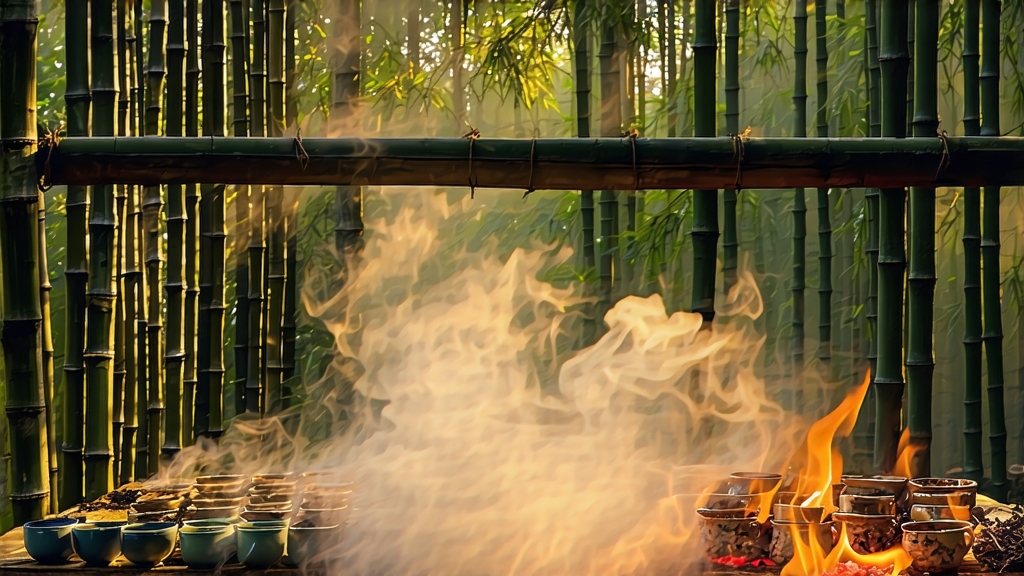
Long before English porcelain teacups clinked in London drawing rooms, the rugged Wuyi Mountains of northern Fujian echoed with the sound of axes splitting pine. It was here, around the mid-seventeenth century, that Lapsang Souchong—today the oldest recorded black tea on earth—was born. Local lore claims passing Qing-era armies delayed the usual drying of fresh leaves; in haste, farmers thrust the semi-oxidized leaf into bamboo baskets suspended over smouldering pine logs. The resulting tea, kissed with resinous smoke and dried fruit sweetness, travelled down the Min River to the port of Xiamen, caught the Dutch East India Company’s eye, and sailed to Europe where it became the prototype for every “black tea” the West would later know. In an age when green teas dominated, Lapsang Souchong redefined what tea could taste, smell, and even symbolize: warmth, mystery, and the exotic Orient captured in a single amber cup.
Geographically, the authentic leaf must hail from Tongmu Guan, a protected enclave inside the Wuyi National Nature Reserve. Granite cliffs, 1,200-metre peaks, and a subtropical monsoon climate shroud the gardens in fog for two-thirds of the year. The mist slows photosynthesis, thickens leaf cuticles, and concentrates aromatic compounds—especially linalool and geraniol—that later translate into honeyed orchid notes beneath the smoke. Soils are yellow-brown laterite, acidic and mineral-rich from weathered volcanic rock; drainage is so sharp that roots plunge deep, pulling potassium and magnesium into the leaf’s polyphenol matrix. Only two cultivars are legally permitted for authentic Lapsang: Xiao Ye Zhong (Small Leaf) and the even rarer Ye Bei, a wild-type bush whose leaves are barely larger than a squirrel’s ear. These micro-terroir factors earned Tongmu Guan the European Union’s Protected Designation of Origin (PDO) status in 2013, the first Chinese tea to do so.
Although the West lumps every smoked tea under “Lapsang,” insiders recognize three distinct styles. Traditional Song Zhong (Pine-Smoke) uses centuries-old techniques: fresh leaves are withered over soft-pinewood fires for eight to ten hours, pan-fired at 200 °C for three minutes to arrest oxidation, then rolled and oxidized for four hours until coppery-red. The critical smoking phase follows: bamboo trays of oxidized leaf are stacked inside a dry room known as a qing lou, while slow-burning pine embers smoulder beneath. Smoke, not flame, drifts upward for six to eight hours; artisans flip the leaf every twenty minutes so each strand absorbs an even cloak of guaiacol and syringol, the same phenols that perfume smoked olives. Finally the tea is charcoal-baked at 80 °C to fix the aroma and reduce moisture to 3 %. The result is a glossy, tar-black strip that smells like pine resin, dried longan, and a whisper of lapsang whisky.
The second style, Wu Zhong (Unsmoked or “Original” Souchong), emerged in 2005 for markets that wanted the malt and cocoa of Wuyi black tea without campfire notes. Leaves are withered naturally on bamboo racks inside drafty corridors, oxidized under 28 °C and 85 % humidity, then baked over charcoal derived from local oak. The cup is burgundy-amber, silky with notes of dark chocolate, rosehip, and a cooling mint finish that echoes the mountain’s camphor forests. Finally, there is Wild Lapsang, harvested from feral bushes seeded by birds on cliff ledges. Picked only in late May, these leaves are half-withered in caves, hand-rubbed to bruise the edges, and smoked for just one hour over pine and cedar. Wild Lapsang is the most ethereal: a ghost of smoke wrapped around flavors of honeycomb, apricot kernel, and wet slate.
Processing adheres to a six-step choreography that has changed little since the Ming dynasty. Withering reduces moisture from 75 % to 58 %, softening cell walls for rolling. Oxidation, catalyzed by polyphenol oxidase, converts catechins into theaflavins and thearubigins, gifting the brisk yet sweet backbone. Smoking is the signature, but baking is the soul: charcoal heat polymerizes remaining sugars, creating caramelized edges that balance the phenolic